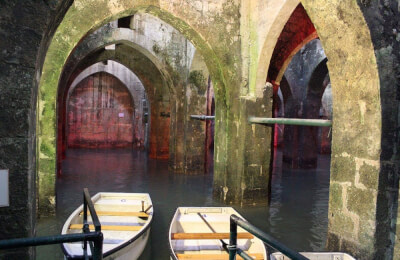
126. Excursion to Ramle - Lod Promotion

135. Pearls of the coastal lowlands Promotion
 165₪
165₪
 165₪
165₪
We also found excursions from other cities that are close to your departure city
Other excursions that also deserve your attention
Discovering the Depths: The Enigmatic Pool of the Arches in Israel
In the heart of Israel, steeped in historical grandeur, lies an architectural marvel lesser-known to the casual traveler but deeply rooted in the historical narrative of the region—the Pool of the Arches. This underground water reservoir, also known as the St. Helena’s Pool, is located in the city of Ramla, a place that is a melting pot of cultures and traditions, and offers an unusual yet fascinating glimpse into the ingenious medieval water collection systems.
The Historical Significance of Ramla’s Underground Wonder
The Pool of the Arches dates back to the 8th century and is an exemplar of the engineering prowess of the Umayyad Caliphate in the land that has seen civilizations come and go. Built by Caliph Sulayman ibn Abd al-Malik in 789 AD, the pool was constructed to provide water for the residents of Ramla, which was then a prosperous and strategically important city in the early days of Islamic rule. The pool's purpose was both practical and grandiose—it collected rainwater to be used throughout the year, and its design reflected the opulence and sophistication of its creators. Its existence is intertwined with the stories of conquests, religions, and the daily lives of the people who have populated this region for centuries.
The Architectural Brilliance of the Pool of the Arches
The Pool of the Arches is an impressive example of medieval architecture, primarily due to its resilient structure and the complexity of its design. The reservoir is roofed by a series of sturdy stone arches, from which it derives its name. These arches are supported by a network of columns that are reflected in the still waters below, creating an almost ethereal and symmetrical aesthetic that leaves visitors in awe. Spanning a total area of approximately 400 square meters and reaching depths of up to five meters, the pool is divided into a grid by the columns and arches, with each square of the grid capable of supporting the massive weight of the structure above. The use of the arches was not only for support; it was also to ensure that the space could span a large area without the need for solid, filled land, allowing more room for water storage.
Exploring the Depths: A Unique Visitor Experience
Today, visitors to the Pool of the Arches can traverse the cool, serene underground expanse by rowboat. The calm waters, the echo of gentle oars breaking the surface, and the play of light and shadow through the arches make for an otherworldly experience. As they navigate the waters, the history of this place seems to come alive, whispering tales of the past through the echoes of the stone. This subterranean aquatic journey is not only a testament to ancient innovation but also offers a respite from the hot Mediterranean sun, serving as a natural climate-controlled environment. The experience of floating through history in the quietude beneath the bustling city above is a profound reminder of the layers of time and civilization that have shaped Israel.
The Ingenious Water System of the Ancient World
The creation of the Pool of the Arches was a response to the water scarcity in the region. By collecting and storing rainwater during the wet season, the ancients ensured a steady supply throughout the drier months. This was a feat of engineering and foresight, allowing the city of Ramla to thrive even in the arid climate of the region. The pool is a surviving piece of a larger puzzle that included a sophisticated water system, with aqueducts and channels directing the flow from afar. The use of gravity, precise stone-cutting, and the understanding of hydraulics all played a role in the functioning of this system, showcasing a level of technical advancement that was remarkable for its time.
The Cultural Tapestry of Ramla and the Pool of the Arches
The Pool of the Arches is not just a cold collection of stones and water; it is a living part of the cultural fabric of Ramla. Over the centuries, this site has witnessed the convergence of different faiths and peoples—Christians, Muslims, and Jews have all left their mark here, contributing to the rich tapestry that makes up the city’s history. The pool has been a silent witness to the prayers of the faithful, the strategic discussions of conquerors, and the daily chatter of townsfolk coming to draw water. It stands as a monument to human ingenuity and resilience, adapting to the changing needs and fortunes of the city above it.
Conservation and Preservation of the Pool of the Arches
Preserving this ancient wonder is a priority for the Israeli authorities and heritage organizations. Conservation efforts have been ongoing to ensure that the Pool of the Arches remains intact, retaining its structural integrity and historical significance for future generations to appreciate. These efforts include controlling the water levels, preventing vandalism, and managing the flow of visitors to reduce wear and tear on the ancient stones.
Visiting the Pool of the Arches: A Step Into History
For those planning to visit the Pool of the Arches, it is recommended to set aside a couple of hours to truly appreciate the site. The city of Ramla offers guided tours, providing historical context and insights that enrich the visitor experience. The best time to visit is during the spring and fall when the temperatures are milder, and the full effect of the atmospheric conditions can be felt. The Pool of the Arches also serves as a starting point for exploring the other historical sites in Ramla, such as the White Tower and the Ramla Market, where the blend of old and new continues to define this fascinating city.
The Timeless Allure of the Pool of the Arches
The Pool of the Arches remains one of Israel's hidden gems, a place where history is not just studied but experienced. The sensation of drifting through its columns on a boat transcends mere sightseeing; it is a journey through time, an immersion in a chapter of the human story that has seen the rise and fall of empires and the steady march of progress. The pool's quiet waters are a mirror to the past, reflecting the changing skies and the enduring spirit of innovation that has long characterized this land. In the heart of Israel, the Pool of the Arches stands as a serene sentinel, inviting travelers to dip their oars into the flow of history and discover the depths of a civilization's legacy.







